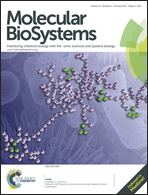Molecular insights of protein contour recognition with ligand pharmacophoric sites through combinatorial library design and MD simulation in validating HTLV-1 PR inhibitors†
Abstract
Retroviruses HIV-1 and HTLV-1 are chiefly considered to be the most dangerous pathogens in Homo sapiens. These two viruses have structurally unique protease (PR) enzymes, which are having common function of its replication mechanism. Though HIV PR drugs failed to inhibit HTLV-1 infections, they emphatically emphasise the need for designing new lead compounds against HTLV-1 PR. Therefore, we tried to understand the binding level interactions through the charge environment present in both ligand and protein active sites. The domino effect illustrates that libraries of purvalanol-A are attuned to fill allosteric binding site of HTLV-1 PR through molecular recognition and shows proper binding of ligand pharmacophoric features in receptor contours. Our screening evaluates seven compounds from purvalanol-A libraries, and these compounds’ pharmacophore searches for an appropriate place in the binding site and it places well according to respective receptor contour surfaces. Thus our result provides a platform for the progress of more effective compounds, which are better in free energy calculation, molecular docking, ADME and molecular dynamics studies. Finally, this research provided novel chemical scaffolds for HTLV-1 drug discovery.


 Please wait while we load your content...
Please wait while we load your content...